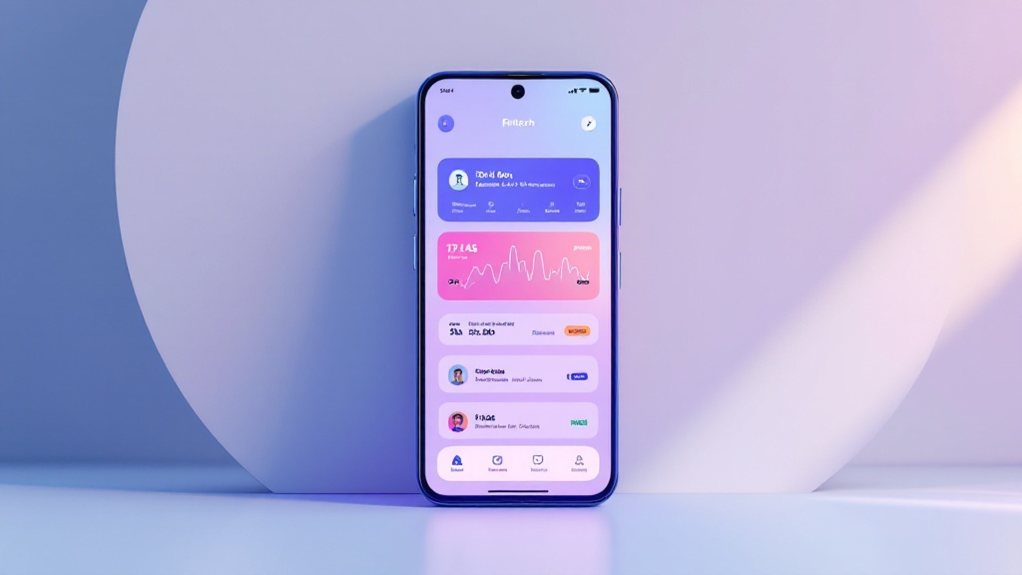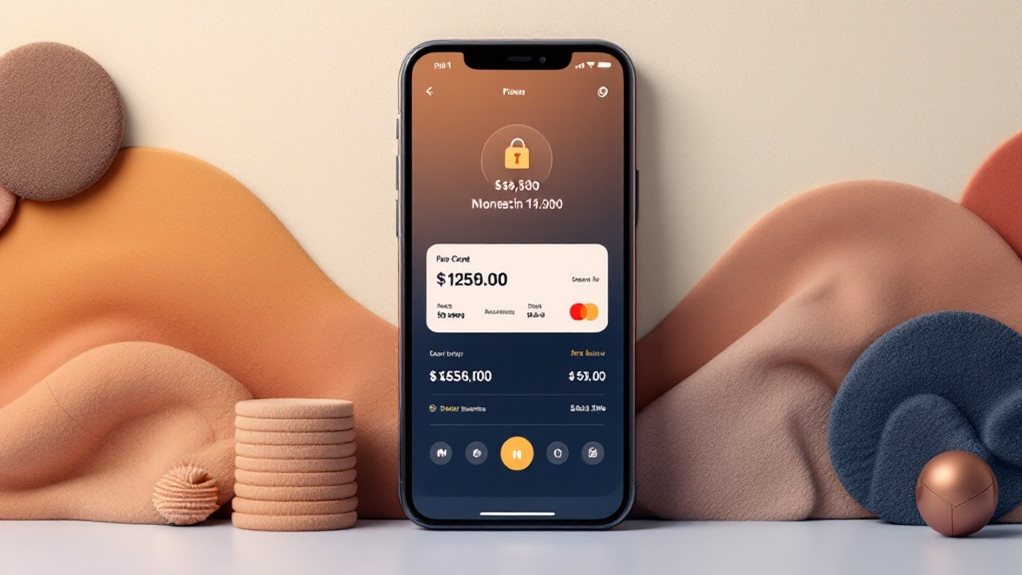To optimize your fintech UX/UI design, you must leverage user data and analytics. Analyze usage patterns, pain points, and customer feedback to segment users and test design elements. Monitor engagement metrics like session duration and conversion rates to identify friction points and refine the interface. Streamline onboarding, implement intuitive navigation, and foster trust through secure authentication. By continuously collecting and acting on user insights, you can deliver an exceptional fintech experience tailored to evolving customer needs. Uncover more strategies to elevate your fintech UX/UI.
Key Takeaways
- Leverage user data analysis to identify pain points, segment target audiences, and continuously optimize the fintech app or website interface.
- Implement A/B testing to gauge user response and inform design decisions, ensuring the fintech experience aligns with evolving customer needs.
- Monitor user engagement metrics, such as session duration and conversion rates, to pinpoint friction points and enhance the overall user experience.
- Streamline onboarding and authentication processes by leveraging biometric authentication and implementing intuitive, mobile-friendly forms to minimize user friction.
- Organize information logically and intuitively, incorporating smart search functionality and progressive disclosure to create a seamless and responsive fintech interface.
Understanding the Fintech Landscape

As you dive into the world of fintech, it's crucial to understand the ever-evolving landscape. Fintech, the intersection of finance and technology, has transformed the way we manage our money, make payments, and access financial services. From digital wallets and mobile banking to blockchain-based platforms and robo-advisors, the fintech ecosystem is teeming with innovative solutions. Stay attuned to the latest trends, regulatory changes, and emerging technologies to navigate this dynamic industry. Understand the needs and pain points of your target audience, whether they're tech-savvy millennials or traditional finance professionals. This knowledge will inform your UX/UI design, ensuring you create seamless, user-centric experiences that meet the evolving demands of the fintech landscape.
Importance of User-Centric Design in Fintech
User-centric design is paramount in the fintech industry, where seamless digital experiences can make or break a product's success. Fintech apps and platforms handle sensitive financial data, so they must prioritize user trust, security, and intuitive workflows. By truly understanding your target audience's needs, pain points, and behaviors, you can craft elegant solutions that delight users and drive adoption. Leverage user research, usability testing, and data analytics to continuously optimize the UX/UI, ensuring it remains responsive to evolving user expectations. Ultimately, a user-centric approach empowers fintech companies to stand out in a crowded market and cultivate long-term customer loyalty.
Leveraging User Data for Informed Decisions

How can you leverage user data to inform your design decisions in fintech? By closely monitoring user behavior, you can uncover insights that drive more impactful UX/UI. Analyze usage patterns, pain points, and feedback to identify areas for improvement. Segment users based on demographics, preferences, and transaction history to deliver personalized experiences. A/B test design elements to gauge user response and iterate accordingly. Continuously collect and analyze data to adapt your fintech app or website to evolving user needs. Embrace a data-driven approach to create frictionless, intuitive interfaces that delight your customers and boost engagement.
Analyzing Customer Engagement Metrics
Analyzing customer engagement metrics is crucial for optimizing your fintech UX/UI. By closely monitoring user interactions, you can uncover valuable insights to enhance the overall experience. Metrics like session duration, page views, and conversion rates provide a window into how users navigate and engage with your platform. Dive deep into user behavior data to identify friction points, high-performing features, and areas for improvement. Leverage this information to refine your interface, optimize user flows, and deliver an exceptional experience tailored to your customers' needs. Remember, data-driven decision-making is the key to unlocking the full potential of your fintech UX/UI design.
Optimizing Onboarding and Authentication Processes

Optimizing your onboarding and authentication processes is crucial for driving user adoption and retention. By streamlining these touchpoints, you can minimize friction and create a seamless user experience. Leverage data analytics to identify pain points and bottlenecks in your onboarding flow. Implement intuitive, mobile-friendly forms and progressive profiling to capture only essential user information. Adopt biometric authentication, such as fingerprint or facial recognition, to enhance security and convenience. Additionally, consider providing clear guidance and contextual help to guide users through the process. Continuous testing and refinement are key to optimizing your onboarding and authentication, ensuring your fintech app delivers a frictionless experience that builds user trust and loyalty.
Enhancing Navigation and Information Architecture
Enhancing your navigation and information architecture is paramount for creating a delightful fintech experience. Streamline the user journey by organizing information logically and intuitively. Leverage clear labeling, intuitive hierarchy, and seamless transitions between pages. Implement smart search functionality to help users find what they need quickly. Incorporate progressive disclosure to manage complexity and prevent cognitive overload. Continuously gather user feedback and analyze behavioral data to optimize the information architecture. Invest in a responsive and mobile-friendly design to cater to diverse device preferences. By prioritizing navigation and information architecture, you'll empower users to access the features they need with ease, driving engagement and satisfaction.
Personalizing the User Experience

Personalization is the next step in elevating your fintech user experience. By leveraging user data and behavioral analytics, you can tailor the interface to individual preferences and needs. This could include customizable dashboards, personalized investment recommendations, or adaptive workflows. Delivering a personalized touch builds trust and loyalty, as users feel the app caters to their unique financial goals. Additionally, personalization enhances engagement, as users are more likely to interact with content and features relevant to them. Ultimately, a personalized fintech experience not only improves user satisfaction but also drives long-term business value through higher retention and cross-selling opportunities.
Integrating Seamless Payment Functionalities
Seamless payment functionalities lie at the heart of any successful fintech application. Integrating a frictionless checkout process is crucial for encouraging user engagement and driving conversions. By optimizing payment flows, you can minimize cognitive load and eliminate unnecessary steps, ensuring a streamlined experience. Leverage data-driven insights to personalize the payment options, making it effortless for users to select their preferred method. Implement secure and intuitive payment gateways, allowing users to transact with confidence. Regularly monitor and analyze user behavior to identify pain points and continuously improve the payment functionalities. Providing a delightful payment experience can foster trust, boost user loyalty, and ultimately contribute to the overall success of your fintech platform.
Addressing Pain Points and Improving Usability

While optimizing the payment functionalities is crucial, it's equally important to address the pain points and improve the overall usability of your fintech application. Analyze user data to identify frustrations and roadblocks, then prioritize solutions that enhance efficiency and intuitiveness. Streamline navigation, simplify complex tasks, and provide clear guidance to ensure a seamless user experience. Leverage user feedback and iterative testing to refine the design, address emerging issues, and maintain a competitive edge. By adopting a data-driven approach, you can create a fintech platform that delights users and drives long-term engagement.
Incorporating Feedback and Iterative Refinement
Incorporating user feedback and consistently refining your fintech application's design is key to maintaining a competitive edge. Leverage user testing, surveys, and analytics to gather insights and identify areas for improvement. Iterate on your designs based on this data, addressing pain points and enhancing usability. Continuously gather user feedback and make adjustments accordingly. This iterative process ensures your fintech UX/UI remains responsive to evolving user needs and market trends. Embrace a data-driven approach and stay agile to deliver exceptional experiences that drive user engagement and loyalty. Ultimately, an iterative, user-centric design process is the foundation for creating a fintech app that stands out in a crowded market.
Fostering Trust and Security in Fintech UX

Trust and security are paramount concerns for fintech users. Fintech UX must prioritize robust authentication, data encryption, and fraud prevention measures. Users want assurance that their sensitive financial information is safeguarded. Incorporate security features seamlessly into the interface, minimizing friction. Leverage biometric authentication, such as fingerprint or facial recognition, to streamline secure access. Provide transparency around data protection policies and allow users to manage their privacy settings. Foster trust by maintaining service reliability and promptly addressing any security incidents. Empower users with control over their financial data. A trustworthy fintech experience cultivates long-term customer loyalty and engagement.
Benchmarking Against Industry Best Practices
When benchmarking your fintech UX/UI against industry best practices, you'll want to assess your design's alignment with established standards and user expectations. Examine how your navigation, information architecture, and interaction flows compare to successful fintech apps. Analyze your visual design, color palette, and typography to ensure they're consistent with the conventions of the industry. Pay close attention to the responsiveness and accessibility of your interface, as these factors significantly impact the user experience. Don't just rely on your own judgment – gather feedback from target users and leverage analytics to identify areas for improvement. Continuous benchmarking against the competition will help you optimize your fintech UX/UI for greater engagement and retention.
Continuous Monitoring and Adaptation

Continuously monitoring your fintech UX/UI and adapting it based on user feedback and analytics is crucial for maintaining a competitive edge. By closely tracking user interactions, you can identify pain points and opportunities for optimization. Leverage A/B testing to gauge the impact of UI changes and quickly iterate. Regularly collect user feedback through surveys and interviews to understand their evolving needs. Analyze usage data to uncover trends and patterns that inform your design decisions. This data-driven approach enables you to proactively enhance the user experience, keeping your fintech app relevant and engaging. Embrace a mindset of continuous improvement – your fintech UX/UI is never truly "finished."

